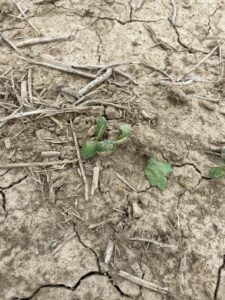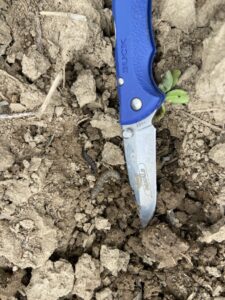Reports are coming in that black cutworm larvae are cutting corn and even soybeans. We don’t often see cutting in soybeans but two fields in Niagara region were reported today with significant stand loss and a variety of sizes of larvae (Figures 1 & 2).


Fields not treated with an insecticide seed treatment or planted with a Bt hybrid containing Cry1F or Vip3A should be scouted every 3-4 days for the next few weeks. Factors that increase field risk include those with pre-plant annual weeds (eg. chickweed, mustards, volunteer wheat, lamb’s-quarters, velvetleaf etc.), cover crops or no-till/reduced till. Delayed burn downs increase the risk of injury, as the larvae feed on the existing plants and weeds while waiting to move over to the corn crop once it emerges. Fields near Lake Erie tend to have more frequent infestations from moths dropping down as soon as they migrate in from the US, but infestations are not exclusive to fields in that area.
Look for pin-holes in leaves and wilting or cut plants above or below ground. Dig around damaged plants to search for cutworms in the soil where they hide during the day. Larvae larger than 2.5 cm are too big to control though some fields may have a range of sizes. Once the corn crop is in the V5 stage, the growing point of the plant is above ground and can tolerate most of the injury and the larger larvae are slowing down in their feeding, only cutting a few more plants before pupating. Foliar insecticide treatments can provide effective control, if applied at threshold and before larvae are larger than 2.5 cm.
For Corn: Spray is warranted if 10% of plants in the first to fourth-leaf stage have damaged leaves/pinholes,
or 3% or more plants are cut and larvae found are smaller than 2.5 cm (1 in.). The risk of damage has passed if
the corn has reached the 5-leaf stage and/or larvae are over 2.5 cm in size.
For Soybeans: Soybeans do a great job at compensating for stand loss. Control of cutworms in soybeans is more based on whether the remaining plant population is still adequate to yield well and may require protection or replanting. Use the hula-hoop method to assess what plant stand is left in several areas of the field. Plant populations of 90 000 on loam soils and 110 000 on heavy clays can still provide excellent yields. More information on how to assess potential replant situations in soybeans can be found here: https://fieldcropnews.com/2020/05/soybean-replant-considerations/. If plant stand loss is significant enough to need to act, also check the size of the larvae. If they are 2.5 cm are larger, they are nearly finished feeding. If the majority of them are smaller than 2.5 cm and stand loss is high, a spray may be warranted.
Foliar insecticides registered for cutworms in corn or soybeans can be found at the OMAFRA Crop Protection Hub: https://cropprotectionhub.omafra.gov.on.ca/ Foliar insecticides should be applied in the evening and the soil left undisturbed for 5 days to ensure the larvae come in contact with the product.
One thought on “Black Cutworm Alert – Corn and Soybeans At Risk”
Comments are closed.